Vasa Previa VS Placenta Previa Symptoms, Management Treatment And what would be the physiologic basis for a placenta previa?
Vasa Previa and Placenta Previa are two different conditions that can occur during pregnancy. Vasa Previa is a rare condition in which the baby’s blood vessels (vasa) run through the membranes covering the cervix. This can cause the baby’s blood vessels to rupture, potentially leading to fetal distress or death. Placenta Previa, on the other hand, occurs when the placenta partially or fully covers the cervix, which can cause bleeding and other complications during pregnancy. It is essential for pregnant women to be aware of both conditions and to discuss them with their healthcare provider.
Pregnancy is a very intimate period for most women. Several women feel they are blessed, and they feel pleased about the new addition in her life. Yet, this period can be precarious for a pregnant woman.
When a woman is pregnant, the chances of complications also increase. Not just in her body but also with her baby. Many complications can be lethal if not treated at the right time.
Although fatal complications are rare, when they do occur, they become of serious concern for the health of the woman as well as the baby.
A few complications that can occur are vasa previa, placenta previa, and placental abruption. We will try to answer the what would be the physiologic basis for a placenta previa?
What Is Placenta Previa?
Placenta previa is a condition that occurs during pregnancy when the placenta partially or fully covers the cervix. This can cause complications during pregnancy and delivery, including bleeding, premature labor, and difficulty delivering the baby. Placenta previa is more common in women who have had previous cesarean deliveries, multiple pregnancies, or who are carrying twins or triplets. Women with placenta previa may require special medical care and may need to deliver the baby by cesarean section to avoid complications.
It’s an organ that develops during pregnancy. It’s the exchange center in which the exchange of nutrients and metabolic waste happens between the mom and the infant.
Typically, a placenta attaches to the upper segment of the uterus or the fundus as the doctors call it. The fundus is the dome-shaped curve of the uterus that consists of the most muscles in comparison to the other parts of the uterus. A lot of muscle gives the placenta the room to get attached to.
In placenta previa, the placenta is attached to the lower segment of the uterus that may or may not cover the cervical opening but lies close to it. This is the lower segment of the uterus that has the least muscle mass.
Click To Learn More: Complications Of Placenta Previa During Pregnancy
What would Be The Physiologic Basis For A Placenta Previa?
The physiologic basis for placenta previa needs to be better understood. However, it is thought to be related to the position of the placenta in the uterus and the structure of the cervix. The placenta is an organ that develops during pregnancy to provide oxygen and nutrients to the growing fetus. It is attached to the uterus wall and has blood vessels that carry oxygen and nutrients from the mother’s blood to the baby’s blood. In a normal pregnancy, the placenta is attached to the top or side of the uterus, but in a placenta previa, it is attached near the cervix or covers the cervix completely.
The physiologic basis for placenta previa is not well understood, but it is thought to be related to the location and attachment of the placenta in the uterus. Factors that may increase the risk of placenta previa include previous cesarean deliveries, multiple pregnancies, and carrying multiple fetuses. It is also more common in older women and women who smoke or use drugs during pregnancy.
Placenta previa can cause complications during pregnancy and delivery, including bleeding, premature labor, and difficulty delivering the baby. It is vital for pregnant women to be aware of this condition and to discuss it with their healthcare provider.
Types Of Placenta Previa:
There are four types of placenta previa:
- Partial Placenta: the placenta is in the lower segment but does not cover the cervical opening. A woman may have no or minimal bleeding through the vagina, and the woman would stay stable throughout her pregnancy. The chances of a natural vaginal delivery are also very high.
- Low lying Placenta: the placenta is almost on the edge of the opening of the cervix. This type is also not a very dangerous situation. A woman may choose to go for a vaginal delivery.
- Marginal Placenta: The placenta is slightly covering the opening of the cervix. A woman may or may not bleed infrequently. Vaginal delivery is a possibility.
- Complete Placenta: the placenta is completely blocking the opening of the cervix. Since the natural passage of birth is completely blocked, vaginal delivery is impossible in such cases. Also, this is the most dangerous type of placenta previa. There are high chances that the woman may bleed profusely.
Symptoms Of Placenta Previa
The most common symptom of placenta previa is vaginal bleeding, which can range from light spotting to heavy bleeding. Other symptoms may include:
- Sharp pain in the abdominal region
- Frequent bleeding during the day
- Bleeding after sexual intercourse
- Bleeding from the vagina in the second or the third trimester
- Abdominal pain or contractions
- Back pain
- Blurred vision or dizziness
- Decreased fetal movement
Placenta previa can cause complications during pregnancy and delivery, and it is essential to receive medical care as soon as possible. You must contact your healthcare provider immediately if you experience any of these symptoms. Your healthcare provider will perform a physical examination and may order additional tests to diagnose placenta previa and determine the best course of treatment.
Management Of Placenta Previa
The management of placenta previa will depend on the severity of the condition and the stage of pregnancy. In some cases, bed rest and close monitoring may be recommended to prevent complications and allow the pregnancy to continue. Hospitalization may be necessary if the placenta previa is causing heavy bleeding or other complications.
In some cases, the delivery may be recommended to prevent complications. If the baby is not yet mature enough to be born, the healthcare provider may try to delay delivery until the baby is mature enough to be born safely. This may involve medications or other treatments to help the baby’s lungs mature.
If delivery is necessary, it will typically be done by cesarean section to avoid complications. After delivery, the healthcare provider will monitor the mother and baby for complications.
It is essential for pregnant women to be aware of placenta previa and to discuss it with their healthcare provider. Early diagnosis and treatment can help prevent complications and ensure a healthy pregnancy and delivery.
- The best way to manage partial complication, your doctor would advise you a complete bed rest and only to do activity when it becomes an utmost necessity.
- You would also be encouraged to forbid from having sexual intercourse strictly
- You may require a blood transfusion in case you have lost much blood
- A safe way out is to undergo a c section to save the life of the mother and as well as the baby
What Is Vasa Previa?
The answer is not very simple we need to understand when a baby is developing inside the womb of the mother, the vessels also develops that connects the blood circulation of the baby to the blood circulation of the mother. These umbilical vessels are the vessels that bring the nutrients from the mother to the baby and then take the metabolic waste from the flow of the baby to the circulation of the mother.
Vasa Previa is a rare condition that occurs during pregnancy when the baby’s blood vessels (vasa) run through the membranes covering the cervix. This can cause the baby’s blood vessels to rupture, potentially leading to fetal distress or death. Vasa Previa is more common in women who have had previous cesarean deliveries, multiple pregnancies, or who are carrying twins or triplets. It is also more common in women who have a low-lying placenta or placenta previa.
In vasa previa, these umbilical vessels are left unprotected by the placenta or the umbilical cord. These vessels then enter the cervical opening. If the vessels are unprotected by any covering, it renders the vessels extremely delicate. The delicate vessels are at a higher risk of bursting and bleeding profusely.
Vasa Previa occurs in 1 in 5000 out of all the pregnancies. Since the complication is very rare, it is easy for vasa previa to go undetected till the child is born. It may even result in the stillbirth of the baby.
Symptoms Of Vasa Previa:
In most cases, vasa previa is not diagnosed due to the lack of symptoms and may only be diagnosed at the time of birth. But if vasa Previa does present with any sign, it will most likely be painless vaginal bleeding that is darker than usual.
The most common symptom of vasa previa is vaginal bleeding, which can range from light spotting to heavy bleeding. Other symptoms may include:
- Abnormal fetal heart rate patterns
- Contractions or abdominal pain
- Back pain
- Blurred vision or dizziness
- Decreased fetal movement
Vasa previa can cause complications during pregnancy and delivery, and it is crucial to receive medical care as soon as possible. You must contact your healthcare provider immediately if you experience any of these symptoms. Your healthcare provider will perform a physical examination and may order additional tests to diagnose vasa previa and determine the best course of treatment.
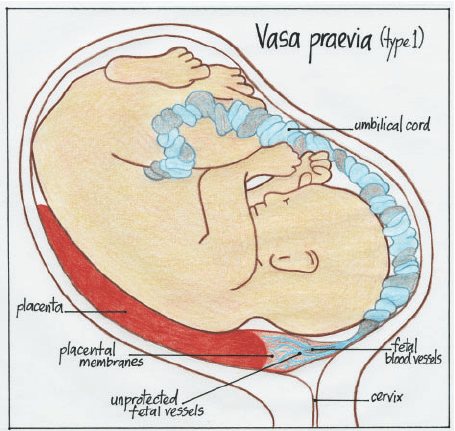
Management Of Vasa Previa:
The management of vasa previa will depend on the severity of the condition and the stage of pregnancy. In some cases, bed rest and close monitoring may be recommended to prevent complications and allow the pregnancy to continue. Hospitalization may be necessary if the vasa previa is causing heavy bleeding or other complications.
In some cases, the delivery may be recommended to prevent complications. If the baby is not yet mature enough to be born, the healthcare provider may try to delay delivery until the baby is mature enough to be born safely. This may involve medications or other treatments to help the baby’s lungs mature.
If delivery is necessary, it will typically be done by cesarean section to avoid complications. After delivery, the healthcare provider will monitor the mother and baby for complications.
- Complete rest is mostly advised. Your doctor would ask you not to move your pelvic region.
- Sexual intercourse must be strictly prohibited.
- Your doctor would administer steroids to mature the lungs of the baby in case of an emergency delivery via c section
- There is a high chance that your doctor suggests you go under a c section to deliver the baby
- You may also require a blood transfusion to help replenish the blood loss you had
Hand Foot And Mouth Disease While Pregnant – Complete Fact Sheet
What Is Placental Abruption?
Placental abruption is Really a complication by Which the placenta detaches from the Walls of the uterus. It occurs suddenly and most commonly near the time of labor. This condition can become very ominous for the mother as well as the baby. The excessive blood loss from the mother can send her into a shock and may require a blood transfusion. It can even result in death if not diagnosed promptly on time.
Placental abruption can be concealed or revealed. Concealed Abruption is the point where the placenta partially detaches in the walls of the uterus but is attached to it. The blood from the abruption is sealed in the partial detachment that has occurred, and it does not come in the vaginal canal, so the woman does not bleed.
Revealed placental abruption is where the placenta has entirely come off the wall of the uterus, and the blood presents as bleeding through the vagina.
Placental abruption is a severe complication that can occur during pregnancy. It occurs when the placenta separates from the inner wall of the uterus before or during delivery, partially or entirely. This can cause bleeding and other complications, including preterm labor, low birth weight, and fetal distress. Placental abruption is more common in women who have had previous pregnancies, are over the age of 35, have high blood pressure or other medical conditions, or smoke or use drugs during pregnancy.
Symptoms of placental abruption may include vaginal bleeding, abdominal pain, back pain, and contractions. If placental abruption is suspected, the healthcare provider will perform additional tests to confirm the diagnosis, such as an ultrasound or fetal monitoring.
Treatment of placental abruption may involve hospitalization and close monitoring of the pregnancy, medications to control bleeding and contractions, or delivery by cesarean section. It is vital for pregnant women to be aware of placental abruption and to discuss it with their healthcare provider. Early diagnosis and treatment can help prevent complications and ensure a healthy pregnancy and delivery.
Symptoms Of Placental Abruption
- Pain in your abdominal region
- Cramping of the uterus
- Tenderness of the abdomen
- Light to heavy vaginal bleeding
- Back pain
- Contractions
- Uterine tenderness
- Abnormal fetal heart rate
- Decreased fetal movement
What would be the physiologic basis for a placenta previa?
A placenta previa is a condition in which the placenta attaches abnormally low in the uterus, often partially or wholly covering the cervix. The cause of a placenta previa is unknown, but it may be due to factors such as uterine abnormalities, increased maternal age, smoking, and multiparity. A placenta previa can cause hemorrhage, preterm birth, and fetal death complications.The physiologic basis for placenta previa is not well understood, but it is thought to be related to the location and attachment of the placenta in the uterus. Factors that may increase the risk of placenta previa include previous cesarean deliveries, multiple pregnancies, and carrying multiple fetuses.
The physiologic basis for a placenta previa is not fully understood. Still, it is thought that the abnormal placement of the placenta may be due to problems with the uterine muscles or the placenta itself. The placenta is a vital organ that supplies nutrients and oxygen to the fetus and removes wastes. It is thought that a placenta previa may be caused by problems with the development of these blood vessels, which can lead to an abnormal placement of the placenta.
If you are pregnant and have been diagnosed with a placenta previa, your doctor will monitor you closely to ensure that you do not experience any complications. Treatment for a placenta previa may include bed rest, medications to prevent haemorrhage, and in some cases, surgery. With proper care, most women with a placenta previa can deliver a healthy baby.
What are the key similarities and differences between vasa previa and placenta previa?
Vasa Previa and placenta previa are both conditions that can affect the placenta. However, vasa Previa is a condition that affects the blood vessels near the placenta. In contrast, placenta previa is a condition where the placenta is located low in the uterus and covers the cervix.
Both vasa previa and placenta previa can cause problems during labor and delivery, but vasa previa is more likely to result in serious problems, such as fetal death. Vasa Previa is also more likely to occur in multiple pregnancies, whereas placenta previa is more likely to occur in first-time pregnancies.
There is no cure for vasa previa, but it can often be detected with prenatal ultrasound and treated with careful monitoring. Placenta previa can be cured if the placenta moves away from the cervix or is surgically removed. However, if the placenta remains in place, a c-section will be necessary to deliver the baby.
Both vasa previa and placenta previa are serious conditions and should be monitored by a doctor. If you experience any symptoms of either disease, such as vaginal bleeding or abdominal pain, contact your doctor immediately.
So, what’s the bottom line? Vasa Previa and placenta previa are both serious conditions that can affect the placenta. Vasa Previa is more likely to cause problems during labor and delivery, while placenta previa is more likely to require a c-section.
References:
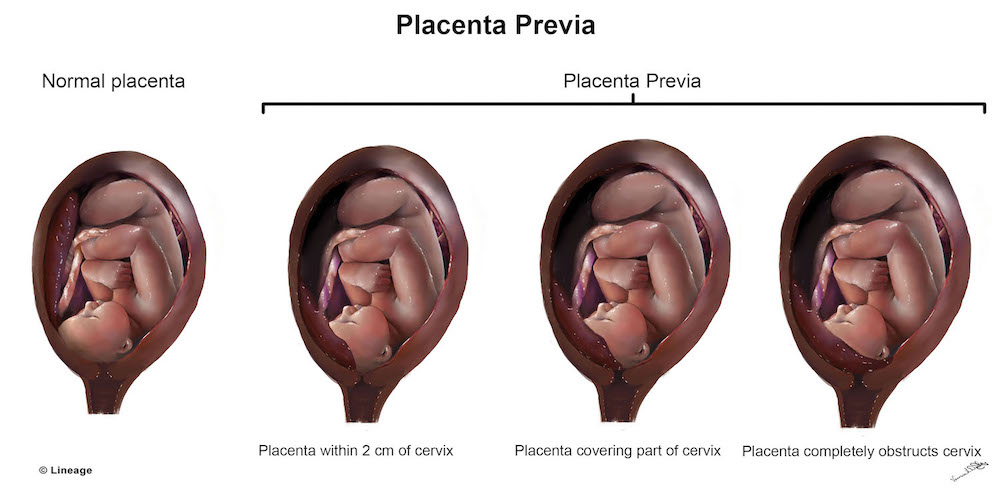
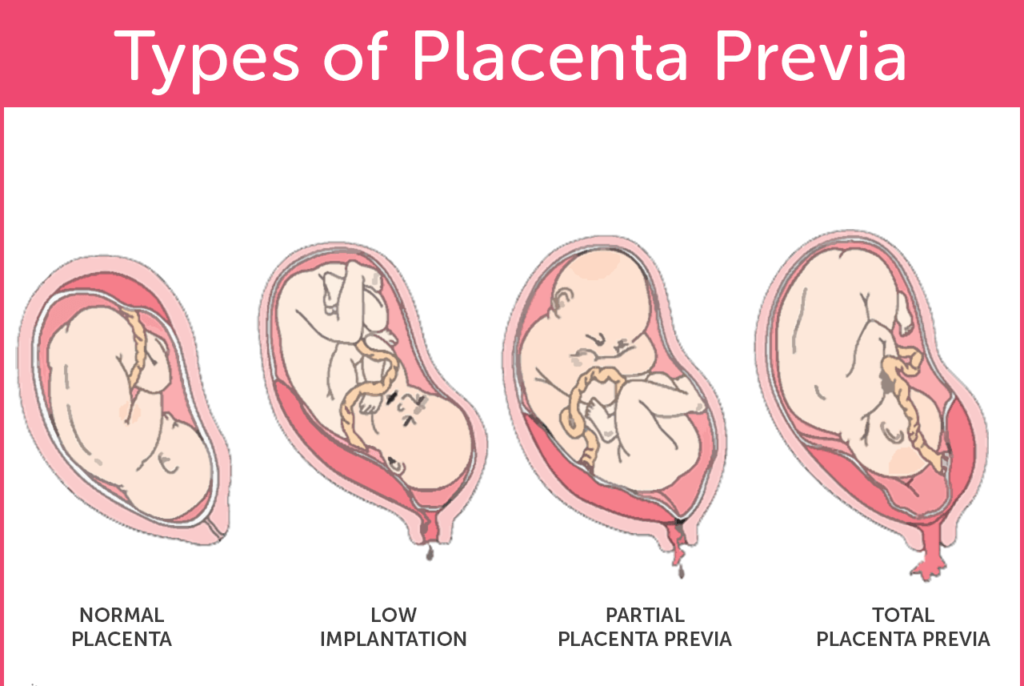
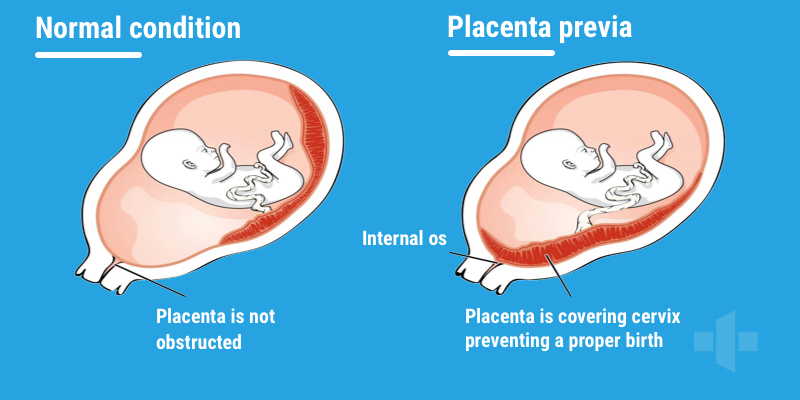
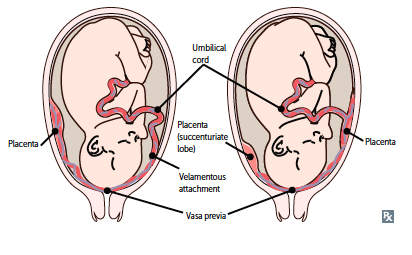
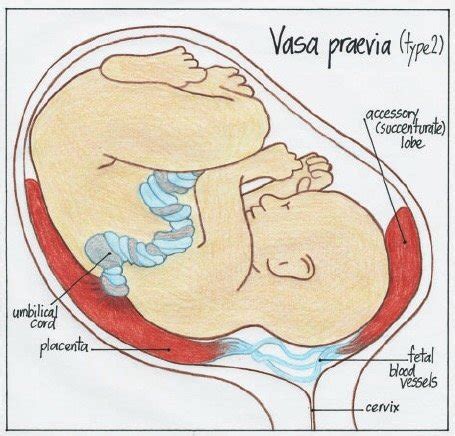



4 Replies to “Vasa Previa VS Placenta Previa Symptoms, Management And Treatment”